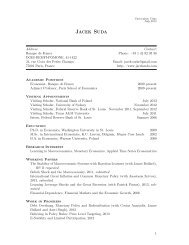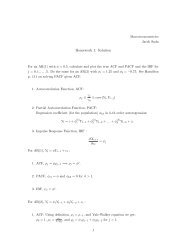Homework 1 - Jacek Suda
Homework 1 - Jacek Suda
Homework 1 - Jacek Suda
Create successful ePaper yourself
Turn your PDF publications into a flip-book with our unique Google optimized e-Paper software.
(j) Estimate an AR(2) model for the time trend case by typing the following in Quick/EstimateEquation, lgdpq c t ar(1) ar(2), with sample period set to 1955:1 1969:4 in the samplefield. Paste output. Click the Forecast button. In the Forecast name field type lgdpqf1.In the Standard Error field type sef1. In the sample range field type 1970:1 2007:3.Click Okay. Type genr uf1=lgdpqf1+1.96*sef1 and genr lf1=lgdpqf1-1.96*sef1 to getstandard error bands. Select lgdpq, lgdpqf1, uf1, and lf1 (hold down the ctrl key toselect multiple series). Click View/Open Selected One Window/Open Group. ClickView again and select Graph/Line. You should have a picture with the series forecastfor the time trend model (with 95% confidence bands) and the actual realized series.Paste graph. What do you notice?NOTE: be very careful to follow directions about sample periods here!!!(k) Again, setting the sample to 1955:1 1969:4, estimate an AR(2) model for the first differencescase (i.e., an ARIMA(2,1,0) model for lgdpq) by typing d(lgdpq) c ar(1) ar(2). Bytyping the equation in this d(*) format, you will get forecasts for the level, rather thanfirst differences. Paste output. Click the Forecast button. In the Forecast name fieldtype lgdpqf2. In the Standard Error field type sef2. In the sample range field type 1970:12007:3. Click Okay. Type genr uf2=lgdpqf2+1.96*sef2 and genr lf2=lgdpqf2-1.96*sef2.Select and graph series as in part j. Paste graph.4




